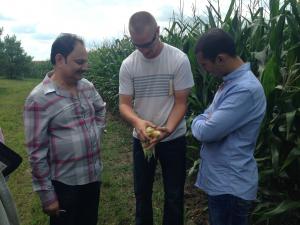Using Market Access Program (MAP) funds, the Council’s marketing program in Saudi Arabia in Calendar Year (CY) 2014 resulted in Saudi Arabia imported 975 thousand metric tons (38.3 million bushels) of corn from the United States, valued at $176 million. This is an increase from CY 2013 when Saudi imported only 355 thousand metric tons (13.9 million bushels) of U.S. corn. The Council invested $85,000 of MAP funds in support of this marketing program generating a Return on Investment (ROI) of $2,000 per every $1 of MAP funding invested.
In Saudi Arabia corn imports are done one of two ways. Either directly by the largest dairy, feed and poultry companies or by relying on Saudi Arabia and international traders to import and provide buyers and end-users with corn and other feed ingredients. The largest importer in Saudi Arabia, ARASCO imports about 1.2 million metric tons (47 million bushels) of corn annually and the Council predicts they will increase to 2 to 3 million tons (78.7 to 118.1 million bushels) in the CY 2015. The Council estimates about 40% of their imports are for their own use and 60% is traded to other end users in the country. The second largest importer in Saudi Arabia, Almarai, imports about 450 thousand tons (17.7 million bushels) of corn annually and is expected to increase their imports to 780 thousand metric tons (30.7 million bushels) over the next three to four years. All of their imports are for their own use in their integrated dairy and poultry system. The rest of the corn imports are done mainly by two multinationals that import corn and trade it to other end-uses.
Using Market Access Program (MAP) funds, in August 2014, the Council invited key feed grain importers, ARASCO and Almarai, and end-users from Saudi Arabia’s two largest dairy operations, NADEC and Al-Safi, to travel to Minnesota, Missouri and New Orleans to meet directly with U.S. producers, suppliers and exporters. NADEC and Al-Safi typically purchase their corn from ARASCO, so it was important to have these participants travel together as one team to provide the same message.
The participants met with key U.S. grain producers and exporters who deal in bulk, as well as, some that specialize in container shipments of feed grains and visited with corn producers, a bulk loading facility and an export elevator. In addition, the team met with companies that deal with testing export quality and handling of other export documentation, which was an eye opening experience for the Saudi team who had not been exposed to this before. By allowing the team to learn about the U.S. supply chain and export channels for exports of U.S. feed grains and co-products, the team gained confidence in the United States’ ability to be the long-term, reliable supplier to their market. As a result of their engagement in this program and the Council on-the-ground marketing efforts, Saudi buyers purchased 975 thousand metric tons (38.3 million bushels) of U.S. corn in CY 2014.
About The U.S. Grains Council
The U.S. Grains Council develops export markets for U.S. barley, corn, sorghum and related products including distiller’s dried grains with solubles (DDGS) and ethanol. With full-time presence in 28 locations, the Council operates programs in more than 50 countries and the European Union. The Council believes exports are vital to global economic development and to U.S. agriculture’s profitability. Detailed information about the Council and its programs is online at www.grains.org.

